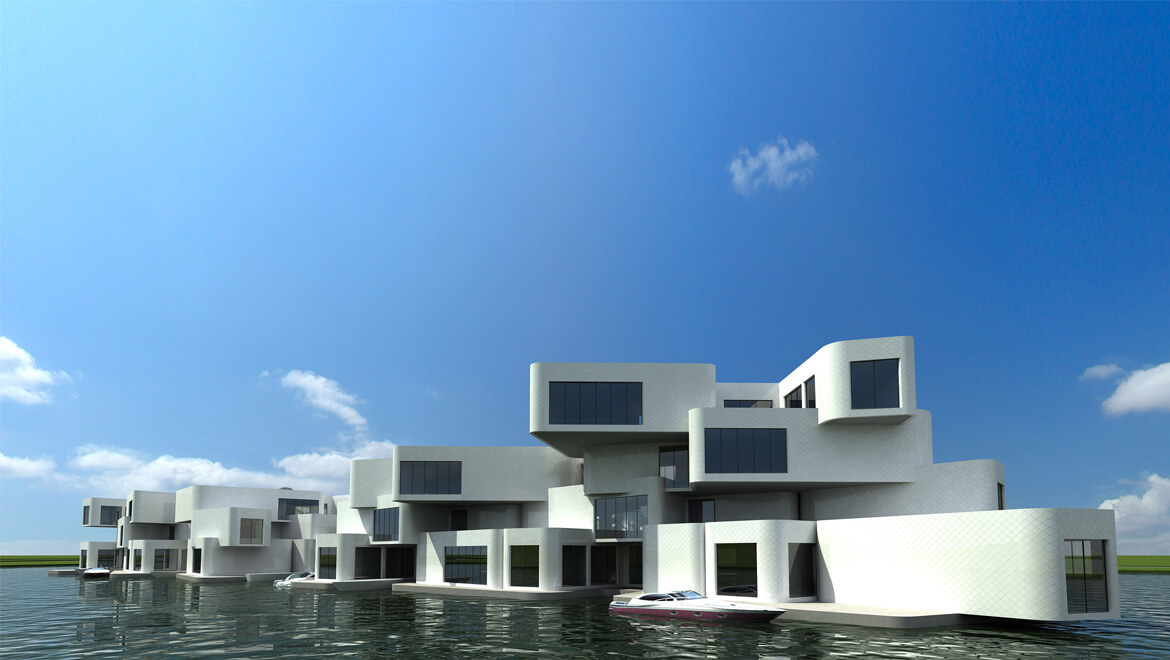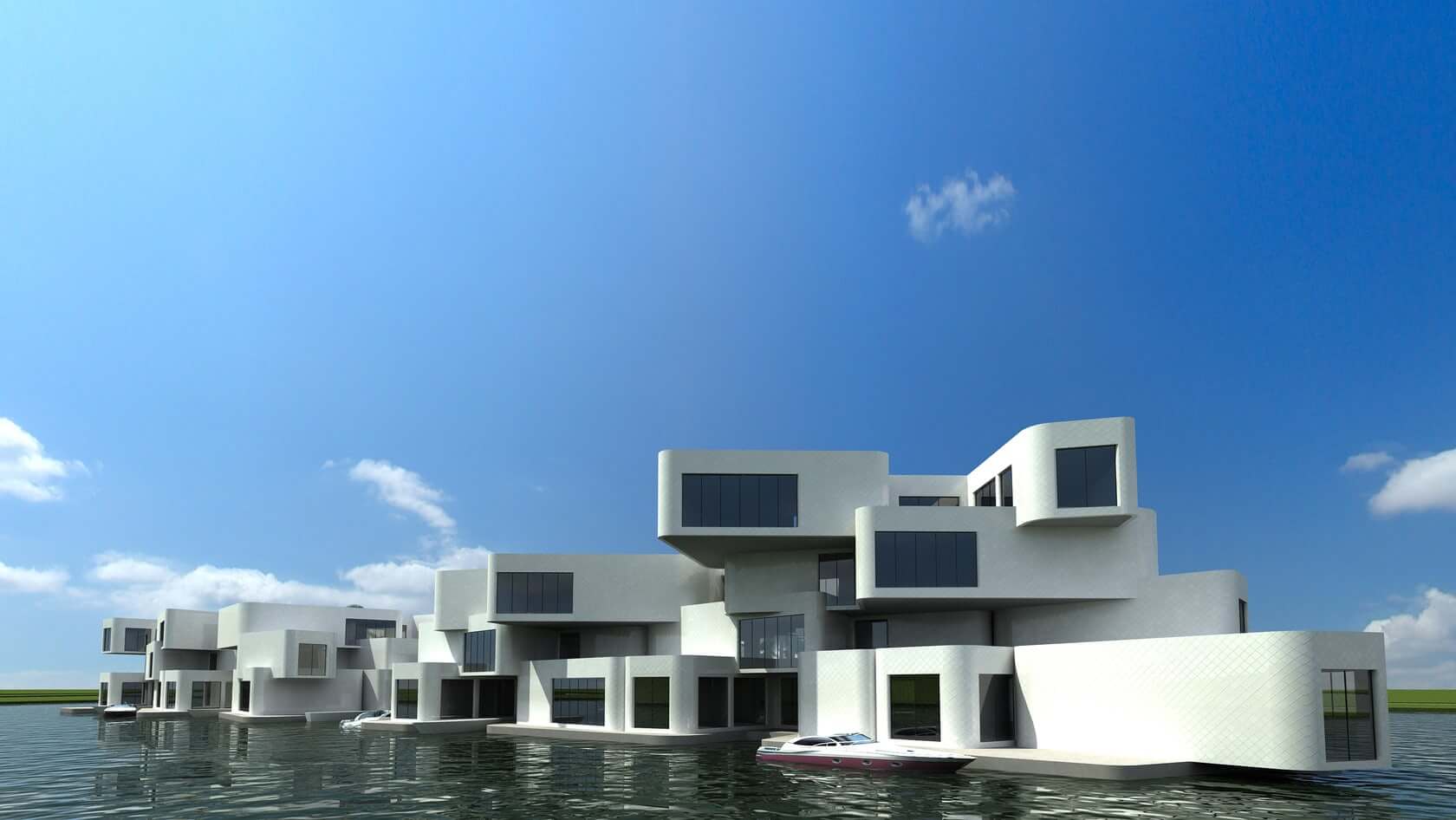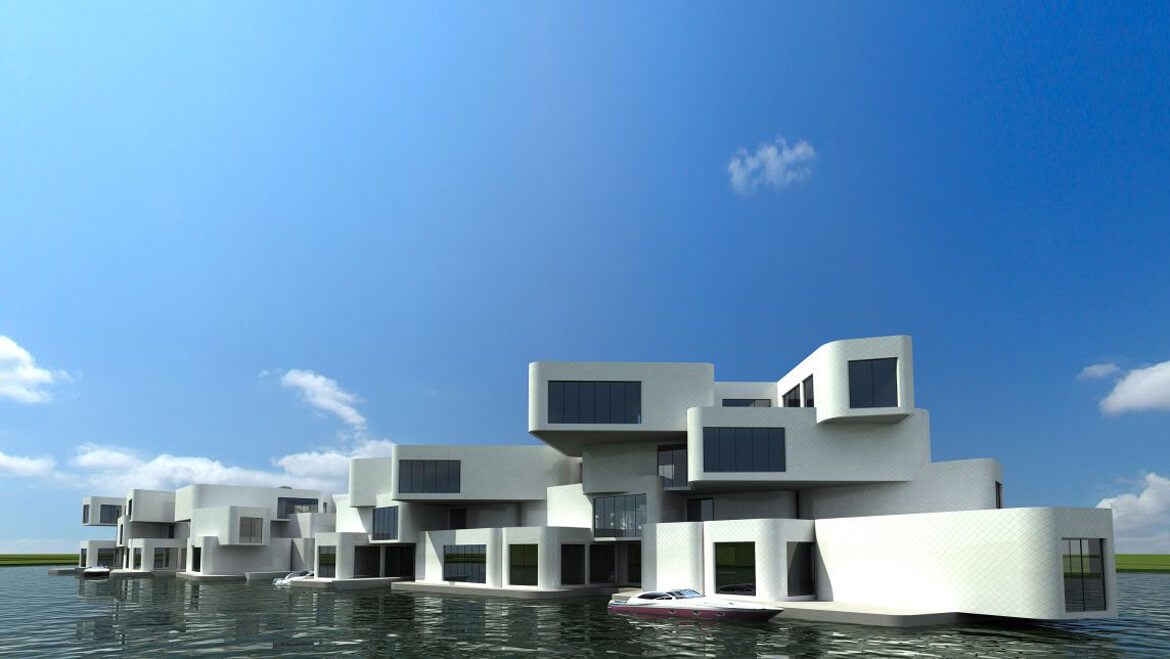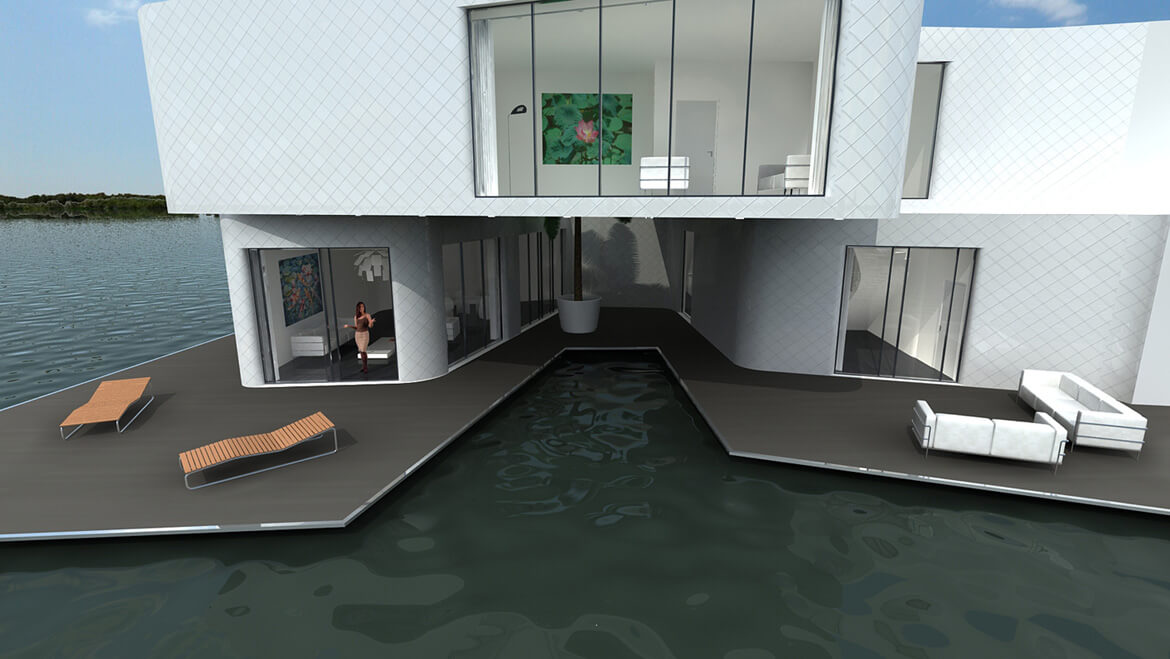WDR Radio – Klimawandel? Kein Problem…
“In the concert of world renowned architects Koen Olthuis is playing the lead when it comes to houses on or close to the water.”
Klimawandel? Kein Problem…
Written by WDR Radio
WDR Radio – Klimawandel? Kein Problem…
Curly hair, casually dressed, no frills, 185 tall, just turned 38, and already almost a worldstar. That is Koen Olthuis, architect from the Dutch town Rijswijk just outside The Hague. In the concert of world renowned architects he is playing the lead when it comes to houses on or close to the water.
The Netherlands respond to flooding with swimming homes

Deutsche Welle, Susanne Henn
The Netherlands respond to flooding with swimming homes
Do houses have to be built on solid land? In response to the climate-induced rise in water level, the Netherlands are turning to an unusual new kind of architecture. Soon, some neighborhoods may float on water.
Dutch architect Koen Olthuis says it’s better for a country that’s threatened by water to learn how to live with it than fight against it – an approach that is central to his work.
The Netherlands are one of the most densely populated yet also flattest countries in Europe. The offices of Olthuis’ firm are beneath sea-level, as is about a third of the terrain in the Netherlands. Water must constantly be pumped back into the sea.
“We pump away about as much water daily as Tokyo and its surroundings use in a year – an incredible amount,” said Olthuis, who decided to specialize in water architecture.
Making flooding valuable
The architect and his team have developed a concept for their country’s future: If the Dutch eventually have to allow water to take over some of the nation’s coastal land surface, the wet area should be used for houses and apartments.
Areas threatened by flooding account for about five percent of the Netherlands’ surface. Currently, they are protected from being overtaken by the sea through the use of dams. Keeping this land dry costs the nation billions annually.
Near The Hague, a joint public and private project called “Het Nieuwe Water” is underway, which foresees building 1,200 new buildings within the next eight to ten years. Some of these are to be floating luxury apartments. At present, though, there is little to be seen in the area – just a 2.5-kilometer (1.5-mile) slushy field occupied by a few homes, greenhouses and a pond.
“First we will build, then we will allow the area to be flooded,” explained Paul van Zundert, an engineer, who will ensure that the residents do not encounter any problems once building begins. “That will be the biggest challenge that arises from this new dual approach to using the water.”
The economic utility of the new buildings will hopefully compensate for the loss of the area’s greenhouses.
Floating neighborhoods
Architect Olthuis would eventually like to move with his wife and three kids to the flooded coastal area. A single family home there will not be more expensive than a traditional home, he pointed out.
“People aren’t interested in having to pay even extra to live on the water. So the only way to go about things is to make the cost of living on the water match that of living on land,” he said. Depending on how it is equipped, a floating house will cost several hundred thousand euros.
The new generation of floating houses has little to do with traditional house boats. Olthuis foresees large platforms which contain everything that belongs in a conventional neighborhood: streets, greenery and rows of houses.
“Climate change is causing water to take up space in cities – area that cities can’t afford to give up,” said the architect. Water collecting in a city center is worthless, he added, but if it can be used as a building site, then it becomes valuable.
The idea is taking hold abroad
By using flexible tubes, the floating platforms will be provided with electricity and hooked up to the sewage system. Oil platforms currently use similar technologies. But the plans go beyond just building houses on the water.
According to Olthuis, the company Waterstudio.NL has already received requests from foreigners interested in floating water parks or golf courses.
The city of Seoul has inquired about a floating park for its downtown area. There is no land available in the area, but there is a river that runs through the city. And a floating mosque in Dubai is also in the works. The mosque will only be reachable by boat, and it is equipped for local climate conditions.
“We will pump sea water through the walls of the structure so as to cool the building from 50 to 30 degrees Celsius. That will save a lot of energy,” Olthuis said.
Consequences of Climate Change and Flood Protection
European Water News: “Acqua alta highlights innovative concepts and examples of successful interaction of modern architecture with water, these examples include presentations by eminent international architects such as Hadi Teherani and Koen Olthuis”
Consequences of Climate Change and Flood Protection
Written by European Water News
NRC international: The city of tomorrow may be build on water

“From mosque to living area, everything can be built floating. Koen Olthuis does it scarless.”
The city of tomorrow may be build on water
Written by NRC Handelsblad international, Tracy Metz
Venedig zum Vorbild nehmen

Hamburger Abendblatt, Rainer Müller
Stadtplaner und Architekten bereiten küstennahe Städte wie Hamburg auf den Klimawandel und den Anstieg der Meeresspiegel vor. Wenn die Deiche nicht mehr reichen, müssen radikale Maßnahmen her. In Venedig etwa stand der Markusplatz noch vor 80 Jahren rund siebenmal pro Winter unter Wasser – heute bereits 50-mal. Mit dem Bau des Milliardenprojekts Mose versucht sich die Stadt zukünftig vor dem Hochwasser, dem “Acqua Alta”, zu schützen: Schleusentore sollen bei herannahender Flut die schmalen Zugänge der Lagune von Venedig zur offenen Adria abriegeln.
“Auch Hamburg wird an einem solchen System nicht herumkommen”, sagt Hamburgs Oberbaudirektor Jörn Walter auf der ebenfalls “Acqua Alta” genannten Fachmesse für Klimafolgen und Hochwasserschutz Mitte November im CCH.
Durch die Begradigung und Vertiefung der Elbe hat sich der Tidenhub in Hamburg innerhalb von 100 Jahren von 1,50 Meter bereits auf 3,50 Meter erhöht. Entsprechend wuchsen die Deiche in die Höhe, um auch gegen Sturmfluten gewappnet zu sein. In Zukunft kommt aber der von Klimaforschern vorhergesagte Anstieg der Meeresspiegel durch die Erderwärmung dazu – mit Folgen für küstennahe Städte: 60 Zentimeter Anstieg werden für die kommenden Jahrzehnte erwartet, und “bis zum Ende des Jahrhunderts rechnen wir für Norddeutschland damit, dass Sturmfluten bis zu 1,10 Meter höher auflaufen können als heute”, sagt Insa Meinke, Leiterin des Klimabüros am GKSS-Forschungszentrum in Geesthacht.
In Wilhelmsburg oder der HafenCity stellt sich die Frage nach Hochwasserschutz besonders dringlich. Eine mögliche Antwort sieht Jörn Walter im “gebäudebezogenen Hochwasserschutz”, also in veränderter Architektur: In der HafenCity werden viele der neuen Häuser daher mit erhöhten Sockelgeschossen errichtet. Stelzenhäuser oder schwimmende Häuser kommen nach Walters Vorstellung für Hamburg auch infrage.
Die Internationale Bauausstellung (IBA) Hamburg präsentierte auf der Messe erste Konzeptideen für “Water Houses”, die bis 2013 als Prototypen in Wilhelmsburg entstehen sollen. Noch schneller, nämlich bereits im Januar, bezieht die IBA selbst eine schwimmende Geschäftsstelle im Müggenburger Zollhafen auf der Veddel. “Angesichts der besonders hohen Deiche auf der Veddel ist der Zugang und selbst der Blick auf das Wasser für die Menschen oft versperrt. Das IBA-Dock zeigt eine Möglichkeit, das Wasser trotzdem zu nutzen”, erklärt IBA-Projektkoordinator Hans-Christian Lied.
Mit flächendeckendem Bau schwimmender Häuser ist aber nach Einschätzung von Jörn Walter und Hans-Christian Lied in Hamburg nicht zu rechnen. “In den Niederlanden ist man da weiter”, sagt der Architekt Koen Olthuis. Er gilt als weltweit führender Architekt für schwimmende Häuser. Sein Büro “Waterstudio” in Rijswijk plant nicht nur Häuser, sondern ganze Siedlungen auf dem Wasser in den Niederlanden und China. “Schwimmende Häuser können vor allem helfen, den Siedlungsdruck an Land abzubauen.”
In den Niederlanden wird jetzt begonnen, durch die Flutung von Poldern neue Siedlungsfläche auf dem Wasser zu gewinnen. In den Niederlanden stehen häufig Gewächshäuser dicht an dicht in den Poldern und verschärfen durch die Oberflächenversiegelung das Hochwasserproblem. In der Gemeinde Westland werden jetzt die ersten Gewächshäuser demontiert, und “im Sommer beginnen wir mit dem Bau der schwimmenden Siedlung ,Citadel’ mit 60 Apartments”, kündigt Olthuis an. “Citadel” wird allen Komfort bieten wie Wohnungen an Land – einschließlich Tiefgarage. “Das ist wichtig: Bewohner dürfen nicht das Gefühl haben, auf etwas zu verzichten. Nur so wird schwimmende Architektur ein Erfolg.”















